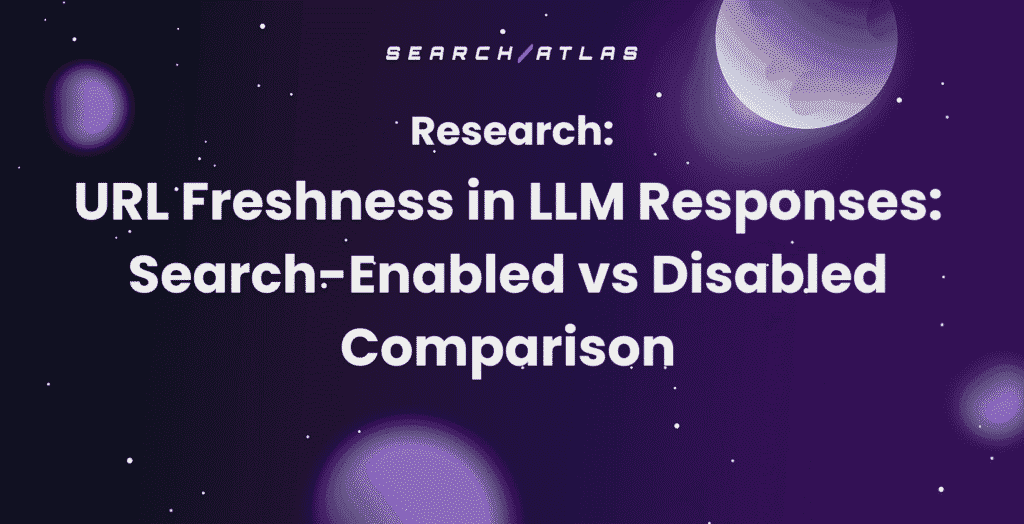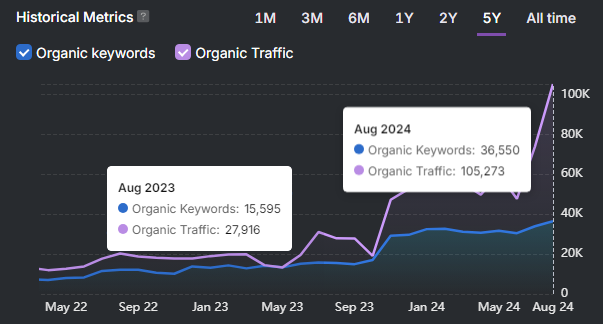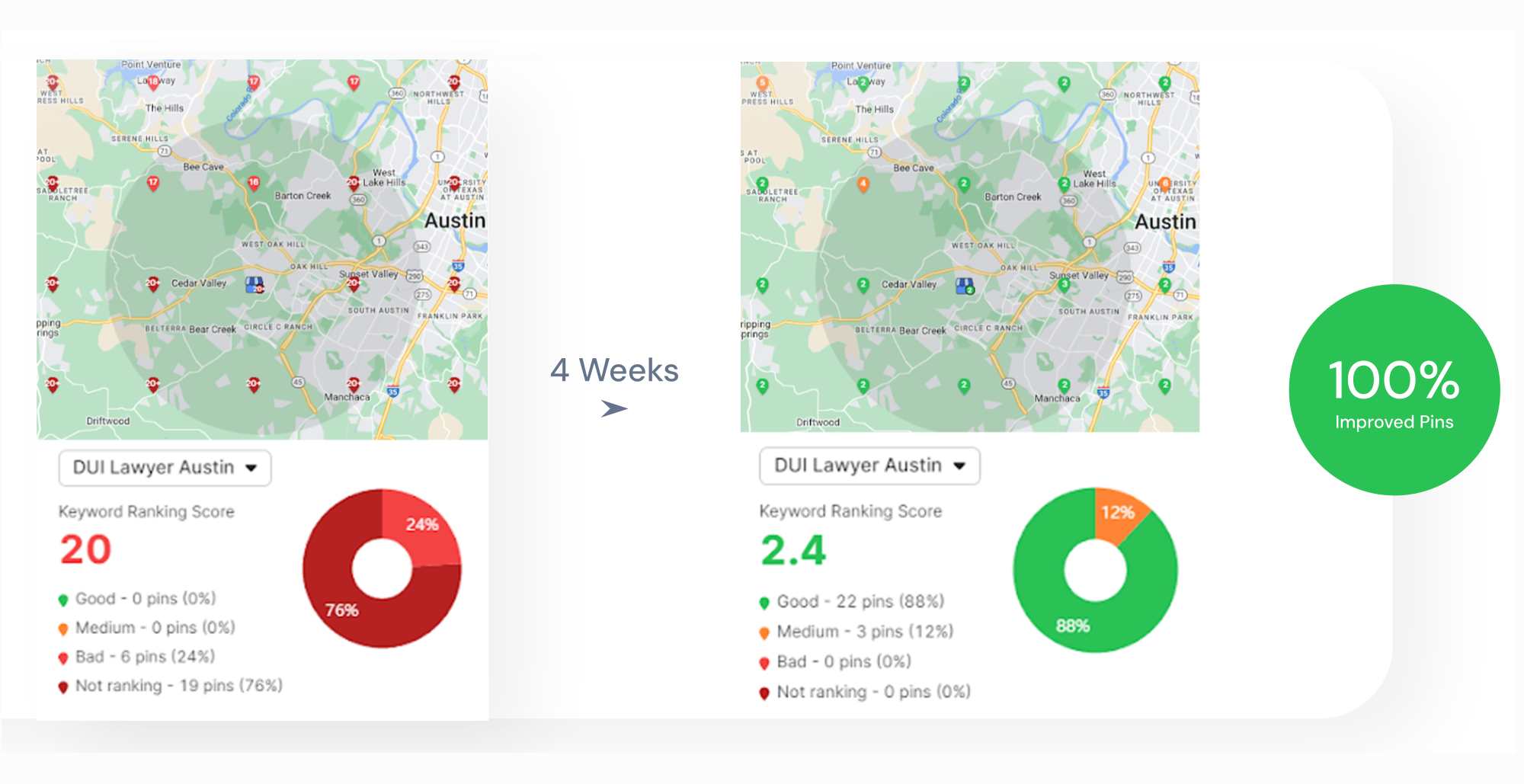Press release distribution sends your announcement to journalists, media outlets, and industry platforms. It ensures your message reaches the right audience through targeted channels, newswires, and editorial contacts. This process drives visibility, builds authority, and supports broader marketing efforts.
A press release captures attention, but distribution unlocks its impact. Media coverage begins with reaching reporters, publishers, and influencers who shape public conversation. Distribution moves your news beyond owned channels into external networks that carry weight with your audience. It transforms a single message into widespread exposure.
What Is Press Release Distribution?
Press release distribution puts your announcement in front of journalists, media outlets, and the public. It sends your press release across networks, newswires, and targeted media lists to ensure visibility in the right channels.
This process gives businesses a direct line to publicity. It delivers news about product launches, updates, partnerships, and achievements to platforms that shape public perception. With the right distribution, a press release drives SEO, builds brand credibility, and sparks media coverage. Most businesses benefit from distributing releases at key moments, not just large corporations or public figures.
A press release alone won’t gain traction. The message must reach the right audience at the right time. Distribution handles that reach. It targets national reporters, local journalists, niche bloggers, and influencers who cover your industry. A strong PR distribution plan makes this coverage possible.

What is the Difference between Self-Distribution and Distribution Service?
Press release distribution happens in two ways: self-distribution or through a distribution service.
Self-distribution involves reaching out directly to reporters, editors, and media contacts. This process requires collecting email addresses, crafting personalized messages, and managing follow-ups. It demands time, attention to detail, and constant list updates. Journalists switch roles and beats frequently, which forces constant maintenance. Mistakes happen easily, and mass emails often end up ignored or filtered.
A distribution service handles the delivery for you. It sends your press release through established networks, newswires, and media databases. This approach reaches a broader audience without manual outreach. It saves time, ensures accuracy, and increases the chance of coverage. While self-distribution relies on a curated network, a service distributes at scale with efficiency and consistency.
How to Distribute a Press Release in 4 Ways?
Effective press release distribution requires a focused strategy. Each way supports authority, search performance, and visibility. A structured approach increases reach, earns media attention, and drives referral traffic.
There are 4 ways to distribute press releases. The 4 ways to distribute press releases are listed below.
1. Use an Automated Press Release Distribution Tool
Automated distribution tools submit press releases to verified newswires and targeted media outlets. These platforms schedule releases, format content, and provide access to curated media databases.
This method expands reach, eliminates manual outreach, and connects announcements with journalists in your niche. Automation increases the likelihood of backlinks and coverage from authoritative sources.
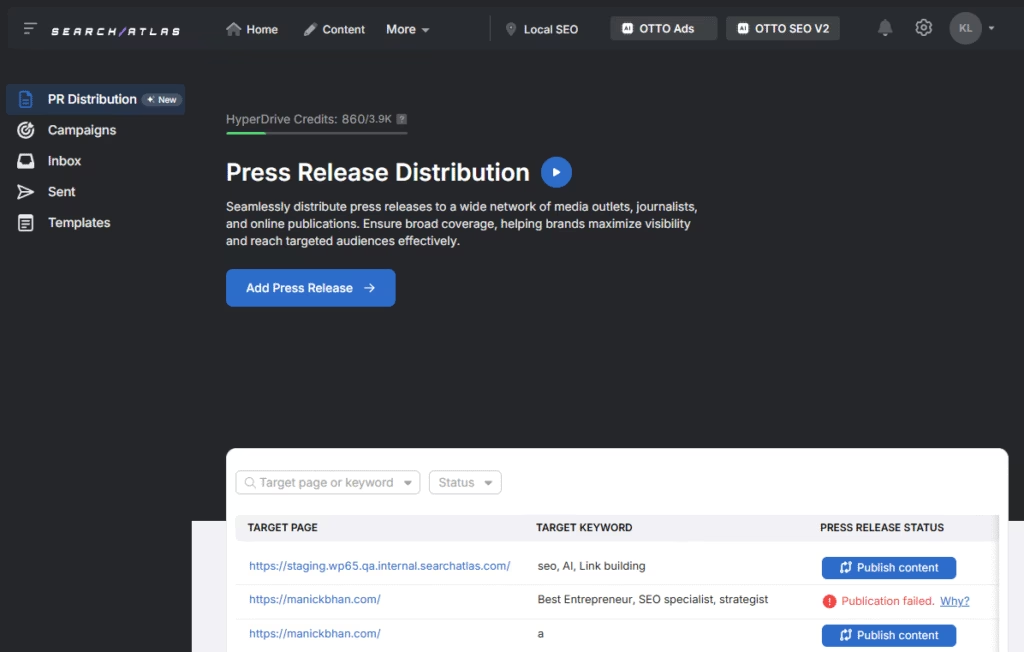
Search Atlas press release distribution tool operates through the Authority Building toolkit. This feature helps increase online visibility, build brand authority, and improve search rankings by distributing AI-generated press releases across high-impact media channels.
Users begin by clicking “Add Press Release” and entering a guided 3-step process.
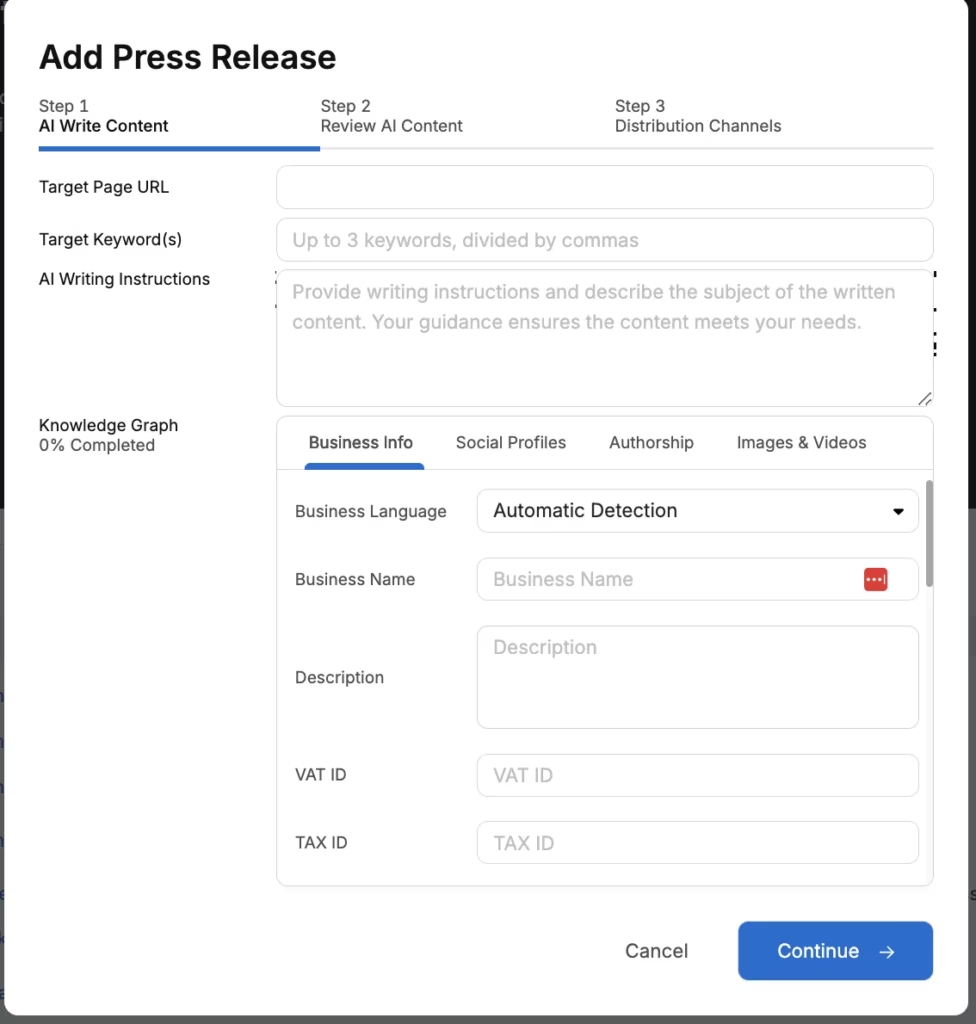
Users provide the Target Page URL, up to three Target Keywords, and specific AI Writing Instructions. These inputs include business details, social profiles, authorship, and media assets like logos, photos, or video links. This information ensures accuracy, branding, and SEO alignment in the final output.
The system generates the press release based on submitted data. Users preview the draft, make edits, and confirm approval by selecting “I reviewed & accept the content.”
2. Share on Marketing Channels
Owned channels play a critical role in distribution. Upload press releases to the company newsroom, share on social media, include in newsletters, and feature in blogs or updates. This multi-channel approach supports brand visibility and long-term SEO value.
Partner announcements gain more traction when both parties publish the release. Backlinks from both domains strengthen domain authority. Consistently publishing to the newsroom improves site crawlability and signals fresh content to search engines.
3. Time the Release for Optimal Visibility
Release timing impacts media pickup and audience engagement. Distribute between 10 a.m. and 2 p.m. local time to align with journalist workflows. Thursday delivers the strongest results, while Friday and weekends show weaker performance.
Align timing with industry patterns and avoid peak news hours. For event or product-related news, send the press release two to three weeks in advance. Embargoed releases require clear terms and lead time. Avoid competing with major headlines to maintain visibility.
4. Use Press Release Syndication
Syndication republishes press releases across third-party sites, aggregators, and industry feeds. This expands reach and places content on trusted platforms. Syndication supports topical authority and reinforces domain strength. This method drives impressions and often attracts additional coverage from blogs and news sites. Each placement strengthens backlink profiles and boosts search engine performance.
What are the Advantages of Press Release Syndication?
Press release syndication distributes a single press release across a wide network of news sites, media outlets, and blogs. This process multiplies exposure, strengthens SEO, and builds brand authority. Each republished version reaches new audiences, extends your message, and reinforces your market presence.
There are several advantages of using press release syndication. The several advantages of using press release syndication are listed below.
- Increased Visibility and Brand Awareness. Syndication places press releases on multiple authoritative platforms. This broad distribution expands reach and connects your message with larger, often industry-specific audiences. More placements mean more eyes on your brand.
- Enhanced SEO Through Backlinks. Syndicated content generates backlinks from trusted domains. These backlinks improve keyword rankings and organic visibility by signaling authority and relevance to search engines. Press release syndication supports long-term SEO goals through consistent off-site signals.
- Sustained Website Traffic. Syndicated releases attract referral traffic across various channels. Use tools like Google Analytics (GA4) to track engagement and identify top-performing outlets. Strong distribution drives consistent site visits beyond the initial announcement.
- Cost-Effectiveness. Compared to paid ads, syndication delivers broader reach at lower cost. One press release creates multi-channel exposure without recurring ad spend. This approach maximizes ROI while supporting ongoing visibility.
- Media Relationship Building. Consistent syndication positions your brand as a credible source. Journalists and editors recognize reliable updates, which increases chances of future coverage. Over time, this builds trust and fosters media connections.
- Strategic Crisis Management. During reputational challenges, syndication pushes a controlled message across multiple channels. This method ensures fast, wide coverage and helps maintain transparency. A clear narrative across outlets protects brand trust and reinforces authority.
How to Do Press Release Syndication?
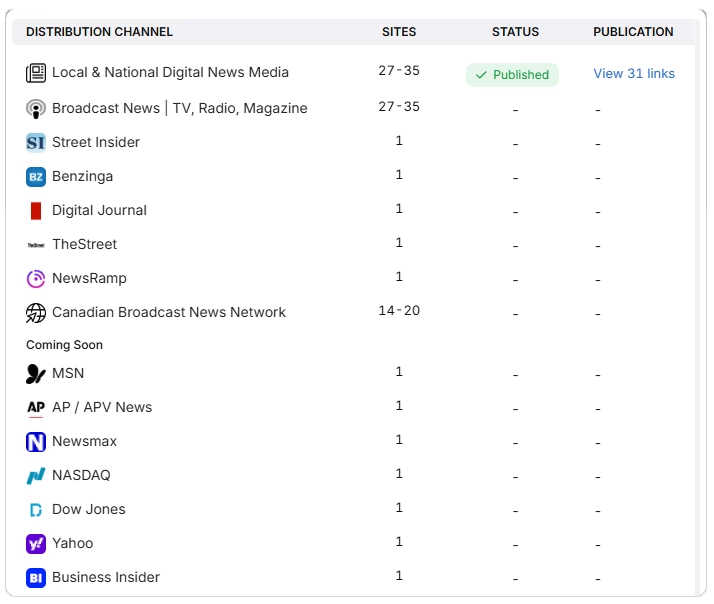
Search Atlas and OTTO SEO enable full press release syndication through a streamlined distribution system. Users begin by selecting from 15 available media distribution channels. Each channel displays its reach and cost in Hyperdrive Credits. The system allows precise targeting and transparent budgeting.
Press release syndication includes optional enhancements:
- Dynamic Press Release (3 credits) creates unique variations tailored to each channel.
- Boost (10 credits) increases reach, adds backlinks, and accelerates indexing across Local & National, Broadcast News, and Canadian News Network outlets.
- Editorial Review (10 credits) applies a professional human review before release.
A real-time summary displays total distribution cost, dynamic variation fee, editorial review charge, and boost cost. Users confirm distribution by clicking “Publish.” The platform processes the request and deducts the selected credits.
After submission, the main dashboard shows live progress. The “View Status” label tracks activity across selected channels. “Published” confirms successful syndication and includes links. “Publish Content” enables resumption of unfinished drafts. OTTO SEO ensures each press release reaches the right outlets with maximum visibility and SEO impact.
Does Automated Press Release Distribution Drive Real Results?
Automating press release distribution and syndication delivers faster execution, broader reach, and stronger results with less effort. Manual outreach wastes time, inflates costs, and limits exposure. Automation removes those barriers. It streamlines delivery, maintains accuracy, and pushes content to the right outlets at scale.
Search Atlas and OTTO handle the entire process—creation, optimization, distribution, and performance tracking—inside one unified platform. Users launch targeted campaigns in minutes, save on labor, and earn consistent SEO value through high-authority backlinks and media placements.
Start using automation that works. Activate your free Search Atlas trial!







